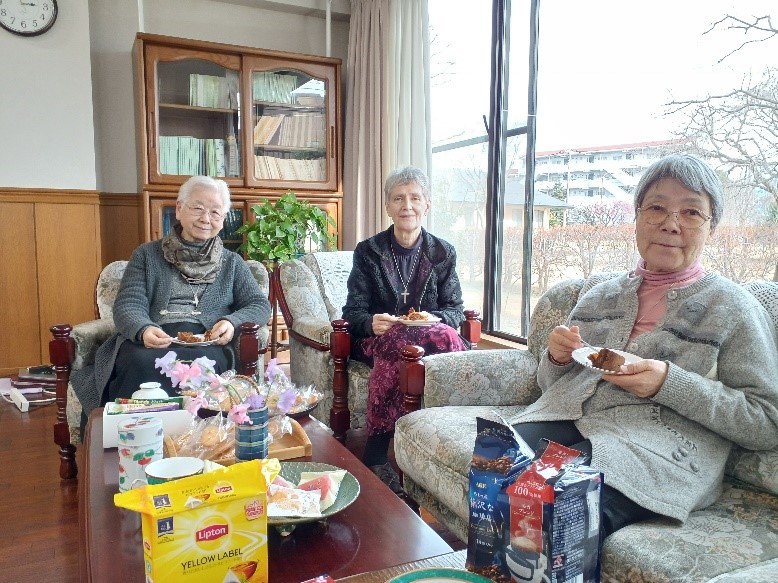News from Maria Province (Japan)
In the garden of Chofu Convent, red and white plum blossoms and daffodils are in full bloom, giving off the fragrance of spring. March will soon be upon us. This month, we were blessed to have Sister Ona Bessette, the Congregation Leader, visit Japan and attend part of our Provincial Council meeting.

As part of the "Actions to promote individual and communal transformation" section of the General Chapter's Orientations, efforts to address the above-mentioned issues are listed. The General Chapter made us aware that discrimination, prejudice, racial issues, human trafficking, exploitation, human rights violations, and issues related to foreigners working in Japan are issues that need to be addressed urgently, and that Maria Province's efforts in this regard are lagging behind the rest. We will hold training sessions and workshops on this issue in the future.
Report
We are pleased to announce the visit of Ms. Marie, a resident of Dubai, to Maria Province. She is a Sri Lankan woman living in Dubai with her family. She is interested in Japanese culture and wishes to experience the Gospel and religious life in Japan, and has been in contact with Sister Yasue Tonari, Sister Motoko Takahashi, Sister Akiko Usui, Sister Sandra Margarita, and Sister Susan Kidd for a year.
She is coming to Japan this April to visit the Congregation de Notre-Dame. Meeting with a young woman from a completely different culture will be an opportunity to deepen our mutual interculturality. Although we have not yet made detailed plans, she hopes to be able to visit Tsukuba and Fukushima.
Toward the 90th Anniversary of C.N.D.'s Arrival in Japan (Vol. 13)
Rose Cauchon C.N.D. from “The Narrow Road to Japan: In the Footsteps of Marguerite Bourgeoys”
Starting to Establish Schools
Fukushima City was spared from bombing and recovered relatively quickly. Many school children were evacuated from the war-torn cities to the countryside, but the war orphans lived by begging, sleeping in stations, under eaves, sheds, and hedges, and stealing food. Their rags had their names, addresses, and parents' names attached to them, so a "parent search" was conducted daily on national radio broadcasts, and some children were returned to their parents, but those who could not be taken in were taken care of by influential people and charitable organizations in each prefecture. The sisters had said to each other during the war that if they were safely saved from this ordeal, they would raise 15 war orphans, and this opportunity soon presented itself. In response to the wishes of the prefectural authorities, two sisters went to Tokyo to visit the homes for war orphans and take in 19 of them.
To raise the children, they began making clothes for them to wear as a first step. Hats were made from fur cloaks left by interned foreign women, their cloaks and clothes were made from khaki-colored blankets given by the army, and summer clothes were made from parachute cloth.
After the war, the number of people who wanted to enter the monastic life increased. The aspirants who joined the order educated orphans with a spirit of service worthy of praise. For children of school age, they opened classes for the first through fourth grades of elementary school, but since there were no school buildings, classes were held in kindergartens. In 1952, the CND General Leadership instructed that the war orphans be returned to their relatives now that life had returned to normal, or if this was not possible, they should be transferred to other Catholic institutions since they were all Christians.
The orphans left Fukushima and were transferred to the home of the Sisters of the Immaculate Conception in Koriyama and to an institution run by the Sisters of the Society of Our Lady of Relief in Tokyo. One of them was received into the Carmelite Order under the name of Sr. Marie Anne, and the other received the grace to join the Congregation of Our Lady of the Angels.
Bishop Urakawa was the spiritual father of the Congregation. He came from Sendai to teach the novices every week. He loved the orphans deeply and baptized them as soon as they were ready to receive the sacraments. In addition to his busy ministry as a bishop, he also translated the Constitutions of the Congregation.
In 1946, Our Lady of the Cherry Blossoms Elementary School (Sakura no Seibo Gakuin Elementary School) was established with 16 orphans as its first children. The administration was taken over by S. Theresia Sasamori, and the number of children increased. At the opening ceremony, Bishop Urakawa explained the meaning of the school’s name "Our Lady of the Cherry Blossoms" as follows.
The cherry tree symbolizes the beauty and purity of a child's heart. In order to attain these virtues, children must look up to Maria, who is a peerless role model, and under her eyes, they must learn and play. On November 23, Kamaboko-type structures was brought from Tokyo as a school building for the elementary school; the sisters were amazed at the small size of the five school buildings loaded on two trucks, but when it came time to unload them, nine workers were needed. At a time when building materials were scarce, the Quonset Huts were purchased with donations from Canada in order to meet the school's immediate needs.
On December 8, the cornerstone laying ceremony was held with Bishop Urakawa officiating, and the Superior placed the Angelus prayer and a Miraculous Medal in the foundation stone.
